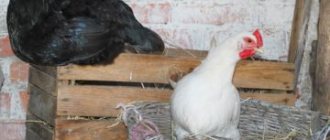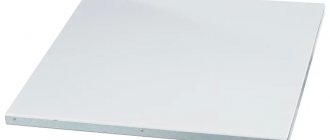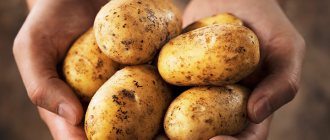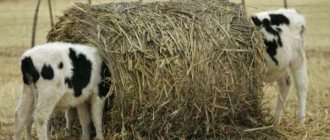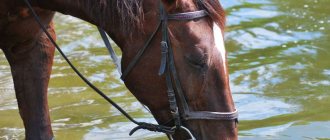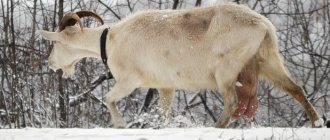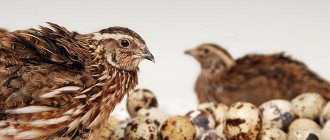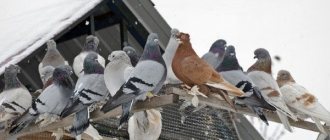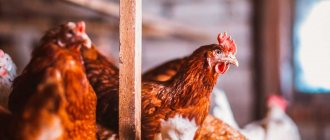Keeping chickens in winter
Keeping chickens in winter is much more difficult than in summer. To do this, you need to stock up on nourishing and nutritious feed in advance, and also properly prepare the poultry house for the cold weather. In general, we can say that the effectiveness of winter rearing largely depends on proper care of the livestock (Figure 1).
Egg production during the cold season may decrease for several reasons:
- In winter, the birds' bodies need additional energy to heat their bodies, so all the nutrients consumed with feed are used for these purposes, and not for the production of eggs.
- During the cold season, chickens often begin to molt, which is also associated with an increased consumption of microelements and nutrients. Accordingly, egg production decreases during this period.
- A significant reduction in daylight hours also negatively affects egg production, so experienced poultry farmers extend it using artificial lighting.
- Lack of fresh green grass deprives chickens of essential vitamins, which will also have negative consequences on egg production.
We can conclude that the complete or partial elimination of these factors will help not only maintain the health of the livestock during the cold season, but also increase the egg production of birds. However, you should be prepared for the fact that in most cases, even with proper maintenance and feeding, the productivity of chickens in winter is still inferior to summer.
Figure 1. Winter maintenance of laying hens
Next, we will take a closer look at the factors that should be taken into account when keeping laying hens and broilers in the winter at home.
Artificial heating
The most common option today is IR lamps. One IR lamp or, alternatively, an IR mirror flask can heat up to 10-12 m². The advantage of such lighting is that it is not the air that warms up, but the objects and surfaces where the rays hit.
In addition, infrared illumination dries the litter and allows you to maintain the required level of humidity. You don’t have to turn off the lamp itself at all – its pleasant light has a calming effect on the hens. Finally, oxygen in the poultry house is not burned, the IR lamp is easy to install and change, and its light helps digest food and strengthens the chickens’ immunity.
Heating a chicken coop using infrared heaters
Note! The efficiency of the infrared lamp is quite high - up to 98%. It not only shines, but also warms - about 90% of all energy is spent on heat.
But IR lamps also have disadvantages - these are, first of all, high electricity consumption, short service life, and frequent cracking in case of moisture. Although this is more a question of proper operation and quality of the lighting devices themselves.
Important! When installing such lamps in the chicken coop, remember: they must be located at least 50-100 cm from heated objects! Chickens also love to jump on everything, including lamps, so it’s worth taking care of ceramic sockets and protective fittings in advance.
If the chicken coop is small, then a 500 W infrared heater will be sufficient.
How to insulate a chicken coop for the winter
When planning to keep chickens not only in summer, but also in winter, first of all you should take care of a comfortable poultry house, because it is in this room that the livestock will spend most of their time.
Note: Living in comfortable conditions is the key to high egg production during the cold season. If the house is warm, dry and light, the chickens will lay eggs well even in severe frosts.
A chicken coop for winter maintenance must meet the following requirements:
- It is better to build the building from durable materials so that there are no through holes or cracks inside through which cold air can penetrate inside. It is also advisable to equip the windows with durable shutters that will help prevent drafts (Figure 2).
- Conventional lamps are installed in the room, which will not only serve as the main source of light, but will also help increase the temperature inside.
- If possible, it is advisable to carry out additional external insulation of the poultry house with any available thermal insulation material. However, experienced poultry farmers do not recommend using polystyrene foam for this purpose, as mice like to feast on it.
Figure 2. Examples of winter poultry houses
It should also be taken into account that in winter, chickens spend most of the day in the poultry house, so before wintering it must be thoroughly disinfected: remove droppings and the old layer of bedding, and then treat the floor, walls and ceiling with a solution of slaked lime. It is also advisable to disinfect feeders and drinkers. This will help maintain the health and productivity of the livestock.
The author of the video will tell you in more detail about the winter maintenance of laying hens.
Chicken coop heating lamp
The maximum egg production of chickens is observed if the daylight hours are 14-18 hours. In winter, such indicators can only be achieved with the help of artificial lighting (Figure 3).
Figure 3. Equipment for heating and lighting the poultry house
It should be borne in mind that only fluorescent lamps should be used to illuminate the chicken coop, since ordinary incandescent lamps will not be able to give the desired effect. They are recommended to be turned on from 6 to 9 am and from 17 to 20 pm.
Note: It should be borne in mind that chickens are very susceptible to stress, and a sudden power outage can reduce their egg production. If you live in a region with frequent power outages, you should consider having a backup power source.
The use of lamps can be useful not only for extending daylight hours, but also for heating the poultry house, but for this purpose it is better to use infrared light devices. Naturally, all equipment must be positioned in such a way that the room is evenly illuminated and heated, and birds cannot reach the lamps.
In case of illness
Chickens are susceptible to many diseases.
The most common are infectious:
- Bronchitis and paralysis;
- Bird flu;
- Colinfection;
- Atypical plague;
- Pasteurellosis.
The first sign of these and other diseases is the occurrence of fever, especially if it is accompanied by the following symptoms:
- Lethargy, refusal to eat;
- Discharge of mucus from the eyes and beak;
- Diarrhea.
Monitoring the temperature of birds will help diagnose diseases in a timely manner.
The temperature of the hen is measured with a thermometer greased with Vaseline, which is carefully inserted into the cloaca. This is the hole through which birds poop.
Temperature for keeping chickens in a chicken coop in winter
Optimal temperature is one of the key indicators of successful chicken keeping in winter. In the cold season, the room temperature should be within +12+18 degrees. To monitor this indicator, it is advisable to install a thermometer inside the poultry house. This is necessary, since a sharp deviation from the norm in any direction will cause stress in the birds and a decrease in egg production.
It is worth noting that in southern regions with mild winters, it is enough to simply insulate the poultry house, and additional heating equipment is not required to maintain the optimal temperature. In temperate and cold climates, such measures will not be enough, so infrared heating lamps, stove, electric or water heating must be installed in the poultry house.
Feeding chickens in winter
Even if you are sure that your chicken coop is fully prepared for winter in terms of temperature and lighting, this does not mean that such measures will be enough to maintain egg production. Without a complete diet rich in nutrients, chickens will not lay eggs, so for their winter maintenance you need to stock up on high-quality feed in advance (Figure 4).
Note: During the cold season, all the nutrients from the feed are used to maintain body temperature, so to get a large number of eggs you need to not only insulate the chicken coop, but also provide the flock with access to nutritious and vitamin-rich feed. Otherwise, the bird’s body reserves will quickly deplete and the productive age will end earlier.
In winter, you can use the following as sources of nutrients and vitamins:
- High-quality compound feed: you can buy it ready-made or make it yourself. The main condition is that this food should contain the maximum amount of nutrients and vitamins.
- Premixes and vitamins: grain feed alone is not enough for winter feeding of chickens. They must be supplemented with special premixes, vitamins for laying hens, mineral supplements and animal feed.
- Wet mashes: These can be an excellent source of nutrients, but be aware that these foods should only be served freshly prepared and warm.
- Cereals and legumes: in winter, chickens happily eat corn, wheat, barley and oats, which can be supplemented with cake, meal, fish and meat and bone meal, table salt or chalk. It is advisable not to crush the grain before distribution, since in its whole form it takes much longer to digest and provides the birds with the necessary nutrients.
Figure 4. Feed for the cold season
The feed distribution schedule also plays an important role. In winter, chickens are fed twice a day, morning and evening, and it is advisable to give out wet mash in the first half of the day, and mixed feed and grains in the second.
Separately, you should install a feeder with small pebbles, sand or shell rock. Chickens will eat them to improve their digestive processes. Water in drinking bowls should be freely available, and it should be changed once a day. Before dispensing, the liquid must be heated, since cold drinking water can cause colds.
Features of feeding
- The frequency of feeding is increased by 2–3 times. With equal breaks between them.
- At least once a week you need to feed sprouted grains and fresh green food.
- An inexpensive and complete source of vitamins, amino acids and fats is fish meal with the addition of a few drops of fish oil.
- The need for animal protein is satisfied by increasing the amount of fermented milk products in the diet: cottage cheese, skim milk, whey.
- Provide birds with constant access to bundles of hay suspended or laid on the floor.
- In addition to boiled ones, they give fresh and juicy, finely chopped vegetables.
Conditions for keeping chickens in the country in winter
If you keep chickens at your dacha, you need to prepare for the wintering of your livestock long before the onset of the first cold weather. First of all, you need to conduct a thorough inspection of the livestock and leave only the youngest, strongest and most productive individuals. It is better to send the remaining chickens to slaughter, since in the cold season they will only waste feed.
Figure 5. Keeping laying hens at the dacha in winter
Next, you need to take care of preparing the poultry house: insulate and disinfect it, install lamps for lighting and heating equipment. You also need to stock up on feed in advance so that the transition to the winter diet occurs smoothly (Figure 5).
Keeping laying hens in a barn in winter
If in the summer your chickens were kept on an open range with light shelter from the rain, but you plan to keep the flock in the winter, you will have to take care of the premises for keeping them. Unfortunately, not all summer residents have the opportunity to quickly build an insulated chicken coop. If you are also one of these people, you will be able to convert an ordinary barn or garage for the winter keeping of livestock (Figure 6).
Note: Chickens are considered very unpretentious poultry, so almost any room can be adapted to their keeping. Surely on your site there is a barn or garage that is quite suitable for housing livestock.
The easiest way is to convert an ordinary barn for these purposes:
- It is better not to place birds over the entire area of the barn, but to fence only a small part of it for them.
- The concrete floor of the room should be covered with wooden boards and a thick layer of bedding, which will help maintain the optimal temperature.
- Additionally, you will have to install lighting sources and arrange high-quality supply and exhaust ventilation in the barn, if it was not equipped there before.
Figure 6. Re-equipment of a barn for laying hens
The remaining requirements for the winter keeping of chickens remain the same, regardless of the type of room. However, experienced poultry farmers still recommend either building a reliable chicken coop for the birds, or keeping them in an unused polycarbonate greenhouse during the winter.
Temperature compliance
In summer, egg production of chickens is much more productive than in winter, this is influenced by heat, lighting and daylight hours, but in winter all this is not enough to correct this situation; poultry farmers use additional measures:
Insulated chicken coop
- install various heating devices: air heaters, infrared lamps and panels for heating and lighting the room, incandescent lamps;
- the layer of insulation on the floor is increased every week by 5-6 centimeters, the litter is turned in order to increase the temperature due to thermal reactions occurring from mixing different materials;
- laying hen nests are installed in places protected from drafts, in secluded corners, insulated with straw and dry leaves.
Advice. If you plan to keep chickens in winter, then when purchasing, give preference to breeds that can withstand low temperatures and at the same time do not reduce productivity. These include laying hens bred in Russia and Ukraine: Ukrainian earflaps, Russian white. Of the foreign breeds that have good winter hardiness, the following are: Minorca, White Leghorn and Blue Andalusian.
Walking chickens in winter
Cold and frost are not a reason to deny birds daily walks in the fresh air. Of course, they will not be able to search for pasture, but fresh air and a certain amount of ultraviolet rays are necessary to maintain egg production.
Note: Outdoor exercise will also help keep your flock at an optimal level of physical activity. If the birds are constantly in the coop, they will stop laying eggs.
To ensure that chickens receive enough vitamin D, which is necessary for the absorption of calcium, they must be allowed out on a fenced range daily. The duration of the walk is determined by weather conditions. For example, in severe frost it will be enough to let the chickens out for a walk for just 10-15 minutes (Figure 7).
Figure 7. Winter walking for chickens
It is advisable that the outdoor enclosure is adjacent directly to the chicken coop: this will make it easier for you to control the livestock during walks. It should be fenced around the perimeter and on top with a net to protect the chickens from rodents and birds of prey. Experienced poultry farmers also recommend laying wooden boards on the floor of the run and covering them with straw to prevent frostbite on the chickens’ feet. To prevent animals from getting bored during a walk, you can hang brooms and bouquets of dried herbs while walking.
The video provides even more useful information about keeping chickens in winter.
Dietary supplements
If the farm does not have its own source of milk and fermented milk products, it is possible to fill the demand for calcium with the help of supplements. An excellent choice is the Feed Shell.
Its use will increase the productivity of birds and affect the strength of the shell. The additive is made from sedimentary rocks of shell rock, which contains a significant amount of calcium and microelements beneficial for the health of chickens.
Adviсe:
- There should always be a container with sand and chalk in the feeding area. Chalk is a source of calcium.
- For normal functioning, birds need to clean the crop from food debris, which is facilitated by small pebbles and grains of sand. Dried and crushed egg shells are also added to the container.
- To increase the vitality of birds, a small amount of potassium permanganate is added to drinking water. This is enough to disinfect the liquid. There should be plenty of water in the chicken coop. If the room is poorly insulated, you need to ensure that it does not freeze.
